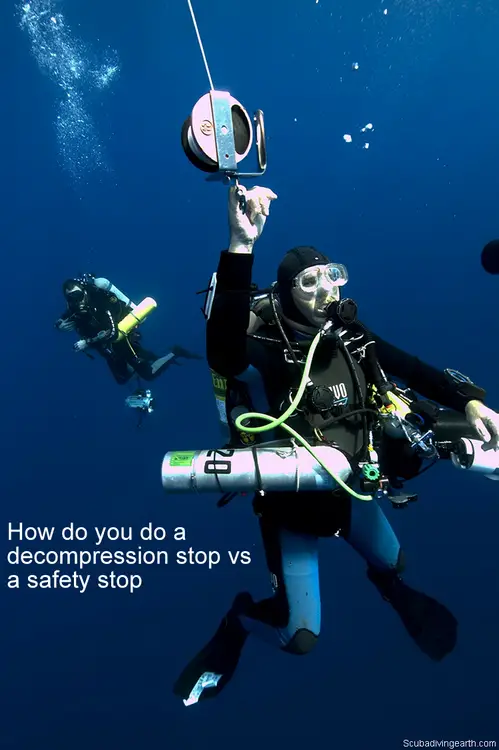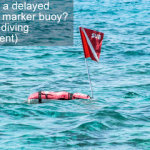
Decompression stops are mandatory vs safety stops which are prescriptive
A decompression stop is mandatory on dives which have exceeded the no stop decompression limit. Whereas a safety stop is a recommended stop on all dives. But what’s involved with doing a decompression stop vs a safety stop?
How do you do a decompression stop vs a safety stop? You do decompression stops and safety stops by remaining at the prescribed stop depth for a set time by becoming neutrally buoyant at that depth. It’s better to decompress in the horizontal position as it makes it’s easier to remain at the stop depth and allows for your entire body to be at the same depth and pressure.
The best way to do more diving is to book yourself on a scuba diving liveaboard. You can check the latest and best deals on liveaboards using the following window:
How to do a decompression stop?
On the assumption you’re planning a dive where you’ll be exceeding the no stop decompression limit, you will need to do a decompression stop.
A decompression stop is a stop at a certain depth for a set amount of time. A decompression stop is to allow your body to continue to decompress. If you miss a decompression stop you risk getting decompression sickness or the bends.
Doing a decompression stop is very easy to do and is most commonly done on a line to the surface.
The line to the surface can either be the shot line put down from the surface from your dive boat. Or alternatively it could be your delayed surface marker buoy you send up at the end of the dive from the bottom.
More Reading: What is a surface marker buoy used for? (Safety diving equipment)
As you ascend you stop by neutralising your buoyancy
Neutralising your buoyancy is controlled by letting out small amounts of air from your buoyancy control device. This is done when you arrive at the depth of your decompression stop.
Becoming neutrally buoyant makes it easier to remain steady at the prescribed depth for the length of time necessary to decompress. At the end of your decompression stop you then:
- Rcommence your ascent to the surface.
- Make sure to stop again at your next decompression stop if you need one.
- Remembering to always do your final safety stop at 5-6 metres (16-20 feet).
More Reading: 12 Decompression Sickness Risk Factors In Scuba Diving and How to Avoid Them
Remain horizontal during your decompression stop
As a useful safety tip, it is further recommended to remain in the horizontal position during your decompression stop.
By staying horizontal you make it easier on yourself to stay at the same depth for the decompression stop time. Plus your whole body is at the same depth and pressure too.

How do you do a safety stop?
To do a safety stop is similar to a decompression stop. A safety stop is also for decompressing. But is done as a safety precaution rather than being mandatory.
It’s recommended to do a safety stop on all dives. If you’re on a dive where you’re ascending without the use of a line, it’s a matter of getting yourself neutrally buoyant at the safety stop depth. This is at 5-6 metres (16-20 feet) for three minutes.
However, if this is your last stop on a decompression stop dive, and you’re using a line from the bottom, you can simply use the line to maintain your safety stop depth. You’ll still need to become neutrally buoyant on your stop. But it’s sometimes easier to maintain a steady depth by holding onto a line.
To calculate decompression stop depths and times is best done using a dive computer
The best way to dive and to be safe, plus to make the right decompression stops at the right depth for the correct amount of time, is to use a dive computer.
Once you exceed the no stop decompression dive limit, you must do the decompression stops to decompress properly. Your dive computer will calculate these stops for you.
However, you must never begin a dive you intend to exceed the no stop decompression limit unless you plan this at the outset. This must be done before you begin the dive.
To do a dive where decompression stops are required when you intend to exceed the no stop decompression time limit, you must first be trained to do this type of dive.
You must also make sure you have the appropriate amount of air supply to carry out the dive. When doing your air requirements calculation, you need to take account of the air required for the decompression stop(s) time during your ascent back to the surface.
I hope you enjoyed this article about how do you do a decompression stop
I’d love to hear from you. Tell us about your adventures of diving and snorkeling, in the comments below. Please also share your photos. Either from your underwater cameras or videos from your waterproof Gopro’s!
If this article hasn’t answered all of your questions. If you have more questions either about snorkeling or scuba diving (or specifically about how do you do a decompression stop), please comment below with your questions.
There will also be many more articles about scuba diving (and snorkeling) for you to read and learn about these fabulous sports.
Have fun and be safe!





